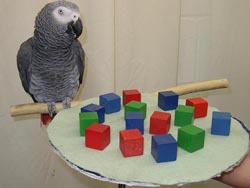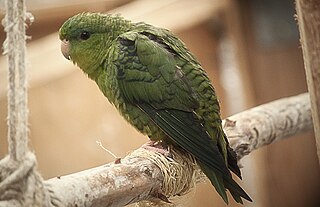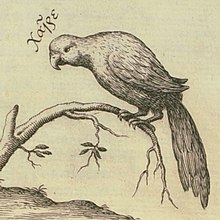
A lyrebird is either of two species of ground-dwelling Australian birds that compose the genus Menura, and the family Menuridae. They are most notable for their impressive ability to mimic natural and artificial sounds from their environment, and the striking beauty of the male bird's huge tail when it is fanned out in courtship display. Lyrebirds have unique plumes of neutral-coloured tailfeathers and are among Australia's best-known native birds.

The budgerigar, also known as the common parakeet, shell parakeet or budgie, is a small, long-tailed, seed-eating parrot. Naturally, the species is green and yellow with black, scalloped markings on the nape, back, and wings. Budgies are bred in captivity with colouring of blues, whites, yellows, greys, and even with small crests. Juveniles and chicks are monomorphic, while adults are told apart by their cere colouring, and their behaviour.
Irene Maxine Pepperberg is an American scientist noted for her studies in animal cognition, particularly in relation to parrots. She has been a professor, researcher and/or lecturer at multiple universities, and she is currently an Adjunct Research Professor at Boston University. Pepperberg also serves on the Advisory Council of METI. She is well known for her comparative studies into the cognitive fundamentals of language and communication, and she was one of the first to work on language learning in animals other than primate species, by extension to a bird species. Pepperberg is also active in wildlife conservation, especially in relation to parrots.

The rose-ringed parakeet, also known as the ringneck parrot or the Kramer parrot, is a medium-sized parrot in the genus Psittacula, of the family Psittacidae. It has disjunct native ranges in Africa and the Indian Subcontinent, and is now introduced into many other parts of the world where feral populations have established themselves and are bred for the exotic pet trade.

The plum-headed parakeet is a species of parakeet in the family Psittacidae. It is endemic to the Indian Subcontinent and was once thought to be conspecific with the blossom-headed parakeet before being elevated to a full species. Plum-headed parakeets are found in flocks, the males having a pinkish purple head and the females, a grey head. They fly swiftly with twists and turns accompanied by their distinctive calls.

The Alexandrine parakeet, also known as the Alexandrine parrot, is a medium-sized parrot in the genus Psittacula of the family Psittaculidae, native to South Asia and Southeast Asia. It is named after Alexander the Great, who transported numerous birds from Punjab to various European and Mediterranean countries and regions, where they were prized by the royalty, nobility and warlords.

Alex was a grey parrot and the subject of a thirty-year experiment by animal psychologist Irene Pepperberg, initially at the University of Arizona and later at Harvard University and Brandeis University. When Alex was about one year old, Pepperberg bought him at a pet shop. In her book "Alex & Me", Pepperberg describes her unique relationship with Alex and how Alex helped her understand animal minds. Alex was an acronym for avian language experiment, or avian learning experiment. He was called the "Einstein of parrots" and at two years old was correctly answering questions made for six-year-old humans.

A companion parrot is a parrot kept as a pet that interacts abundantly with its human counterpart. Generally, most species of parrot can make excellent companions, but must be carefully managed around other common pet species like dogs and cats as they might be hostile towards them.

The blue-winged parakeet, also known as the Malabar parakeet is a species of parakeet endemic to the Western Ghats of southern India. Found in small flocks, they fly rapidly in forest clearings while making screeching calls that differ from those of other parakeet species within their distribution range. Their long blue tails tipped in yellow and the dark wings with blue contrast with the dull grey of their head and body. Adult males and females can be easily told apart from the colour of their beak.

The echo parakeet is a species of parrot endemic to the Mascarene Islands of Mauritius and formerly Réunion. It is the only living native parrot of the Mascarene Islands; all others have become extinct due to human activity. Two subspecies have been recognised, the extinct Réunion parakeet and the living echo parakeet, sometimes known as the Mauritius parakeet. The relationship between the two populations was historically unclear, but a 2015 DNA study determined them to be subspecies of the same species by comparing the DNA of echo parakeets with a single skin thought to be from a Réunion parakeet, but it has also been suggested they did not constitute different subspecies. As it was named first, the binomial name of the Réunion parakeet is used for the species; the Réunion subspecies thereby became P. eques eques, while the Mauritius subspecies became P. eques echo. Their closest relative was the extinct Newton's parakeet of Rodrigues, and the three are grouped among the subspecies of the rose-ringed parakeet of Asia and Africa.

The barred parakeet, also known as the lineolated parakeet or the Catherine parakeet, is a small parrot found disjunctly in highland forests from southern Mexico to Panama, in the Andes from western Venezuela to southern Peru and Bolivia, the Santa Marta Mountains in Colombia and the Venezuelan Coastal Range. Its plumage is mostly green with multiple black and dark green stripes or bars, and it has a pale-horn coloured beak. The dark stripes vary in prominence between its two subspecies. Several colour mutants are available in aviculture.

The superb lyrebird is an Australian passerine songbird, one of two species from the family Menuridae, with the other being the much rarer Albert's lyrebird. It is one of the world's largest songbirds, and is renowned for its elaborate tail and courtship displays, and its excellent mimicry. The species is endemic to Australia and is found in forest in the southeast of the country. According to David Attenborough, the superb lyrebird displays one of the most sophisticated voice skills within the animal kingdom—"the most elaborate, the most complex, and the most beautiful".
N'kisi is a grey parrot thought to exhibit advanced English talking skills and other abilities.

A feral parrot is a parrot that has adapted to life in an ecosystem to which it is not native. The birds are often descended from pets that have escaped or been deliberately released. Many species of parrots are highly social, and like to gather in large flocks. Not all feral parrots are able to adapt to life outside of captivity, although having a pre-existing nearby parrot colony can assist with the adaptation process.
A talking animal or speaking animal is any non-human animal that can produce sounds or gestures resembling those of a human language. Several species or groups of animals have developed forms of communication which superficially resemble verbal language, however, these usually are not considered a language because they lack one or more of the defining characteristics, e.g. grammar, syntax, recursion, and displacement. Researchers have been successful in teaching some animals to make gestures similar to sign language, although whether this should be considered a language has been disputed.

Parrots (Psittaciformes), also known as psittacines, are birds with a strong curved beak, upright stance, and clawed feet. They are conformed by four families that contain roughly 410 species in 101 genera, found mostly in tropical and subtropical regions. The four families are the Psittaculidae, Psittacidae, Cacatuoidea (cockatoos), and Strigopidae. One-third of all parrot species are threatened by extinction, with a higher aggregate extinction risk than any other comparable bird group. Parrots have a generally pantropical distribution with several species inhabiting temperate regions as well. The greatest diversity of parrots is in South America and Australasia.

Birds of Eden is the world's largest free flight aviary and bird sanctuary, located in Kurland village near Plettenberg Bay in the Western Cape, South Africa. The mesh dome of the sanctuary was built over 2.3 hectares of indigenous forest, and is up to 55 metres (180 ft) above ground level. 1.2 kilometres (0.75 mi) of walkways, about 75% of which are elevated, let visitors see the birds at all levels of the aviary.

The Mascarene grey parakeet, Mauritius grey parrot, or Thirioux's grey parrot, is an extinct species of parrot which was endemic to the Mascarene Islands of Mauritius and Réunion in the western Indian Ocean. It has been classified as a member of the tribe Psittaculini, along with other parrots from the Islands.

The grey parrot, also known as the Congo grey parrot, Congo African grey parrot or African grey parrot, is an Old World parrot in the family Psittacidae. The Timneh parrot (Psittacus timneh) once was identified as a subspecies of the grey parrot, but has since been elevated to a full species.

Apollo is an African grey parrot and the subject of the popular YouTube channel "Apollo and Frens" run by Victoria (Tori) Lacey and Dalton Mason. Apollo has been described as having the intelligence of a "human toddler" and can answer numerous complex questions in English.

















